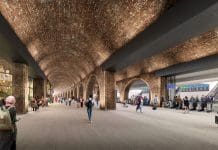Structural Soils conducted the latest round of site investigations from a barge for the planned Royal Victoria Dock cycle bridge
Preparations for the 305-metre S-curve design pedestrian and cycle bridge at Royal Victoria Dock are underway, which upon completion, will link the ExCel centre and Custom House station on the north side of the dock with Silvertown.
The Royal Victoria Dock cycle bridge is part of the £5bn Silvertown Partnership development
The work for Lendlease also involved ground investigation work using cable percussion and rotary coring, along with laboratory and in-situ testing.
The bridge was funded with a £233m loan from Homes England to support the delivery of over 6,000 homes on site.
The Royal Victoria Dock cycle bridge is part of the Silvertown development, which is estimated to be completed in 2036.
Overwater site investigations required a methodical approach
Structural Soils, an RSK Group company, said overwater boreholes formed part of the investigation work with the team operating through an 11m water column before cable and rotary drilling operations could be undertaken to 45m with the company’s new high pressure dilatometer capability testing forming part of this work.
Senior engineering project manager Gareth Jones said: “The team is accustomed to overwater work and so the marine environment is not new to us. In this instance, however, we worked from the deck of a 18m x 18m jack-up barge with both a Dando 2500 cable rig combined with a rotary MC450P rig of 9,000kg gross weight and a mast height of 6.2m. With limited space available to us on the deck, it was crucial for the team to plan and co-ordinate our mobilisation and operations precisely.
“The project also required piezocone penetrometer tests (pCPT) to determine soil type and conditions and land-based trial pits were undertaken to help the client understand surface soil conditions and to assess the dock wall structural arrangement.”
Co-ordination and collaboration were key
Gareth added that one borehole presented positive artesian water pressure, forcing soils up the drill string, which required Structural Soils to mobilise additional equipment to the site and alter the drilling technique, using a thick polymer mud to advance the borehole.
The jack-up barge legs, which reached 20m in height, required the team to co-ordinate its work with the London Airport flight schedule to ensure barge movements did not disrupt air traffic.
RSK Safeground carried out the ground penetrating radar (GPR) for the land-based trial pits with another RSK company, Envirolabs, undertaking geo-environmental testing.
















